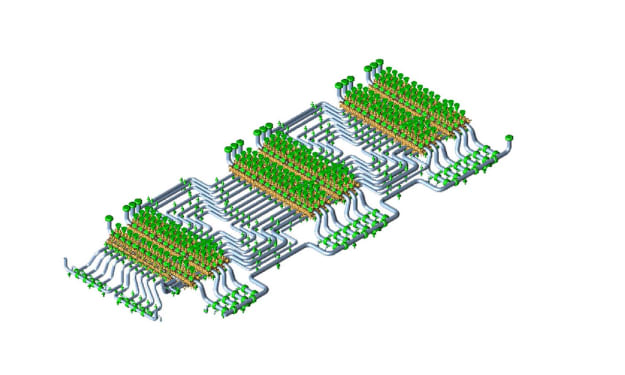
Piping design is a specialized field of engineering that involves the planning, creation, and optimization of a network of pipes to transport fluids, gases, and other materials within industrial facilities.
These piping systems are the lifelines of various industries, including oil and gas, petrochemicals, power generation, chemical processing, pharmaceuticals, and more.
Piping design is crucial for the efficient and safe operation of industrial processes, and it requires meticulous planning, engineering expertise, and adherence to industry standards. In this article, we will explore the fundamental aspects of piping design and its significance in modern industries.
Piping design refers to the process of planning, creating, and optimizing the layout and specifications of pipelines and piping systems used to transport fluids (liquids or gases) from one location to another within various industrial, commercial, and residential settings.
These systems are essential for the safe and efficient conveyance of fluids in industries such as oil and gas, petrochemicals, pharmaceuticals, power generation, water treatment, and more.
Key Components of Piping Design:
1. Layout and Routing: The layout and routing of piping systems are essential considerations in piping design. Engineers must determine the most efficient paths for fluid flow while avoiding clashes with other equipment, structures, or piping lines. Proper routing ensures easy access for maintenance and reduces pressure losses during fluid transportation.
2. Material Selection: The choice of materials for piping systems depends on factors such as the nature of the transported fluid, operating temperature, pressure requirements, and environmental conditions.
Commonly used materials include carbon steel, stainless steel, PVC, HDPE, and various alloys. Material selection ensures compatibility with the fluid being transported and resistance to corrosion and degradation.
3. Pipe Sizing and Pressure Drop Calculation: Determining the appropriate pipe size is critical to maintain the required flow rates and minimize pressure drop along the pipeline. Engineers use hydraulic calculations to analyze pressure drop and optimize the pipe dimensions accordingly.
4. Support and Anchoring: Piping systems need adequate support and anchoring to prevent excessive vibration, thermal expansion issues, and stress on equipment connections. Proper support ensures the integrity and stability of the piping network.
5. Stress Analysis: Piping systems undergo various loads and stresses during operation, including pressure, thermal expansion, and external forces. Stress analysis helps identify potential weak points and ensures the pipes can withstand the operational conditions without failure.
The Significance of Piping Design:
Piping design is of utmost significance in the industrial landscape:
1. Efficiency and Cost-Effectiveness: A well-designed piping system ensures the efficient transportation of fluids, minimizing energy consumption and operational costs. Proper layout and sizing reduce pressure losses, leading to improved process efficiency.
2. Safety and Reliability: Safety is a paramount concern in any industrial process. Proper piping design prevents leaks, spills, and accidents, safeguarding personnel, equipment, and the environment. It ensures the reliable transportation of materials without interruptions.
3. Compliance with Standards: Piping design adheres to industry-specific codes, regulations, and standards. Compliance ensures that the piping systems meet quality and safety requirements, and it enables seamless integration with other plant components.
Piping design is a critical aspect of engineering projects, and it requires collaboration between different engineering disciplines to deliver a well-functioning and safe piping system. Properly designed piping systems contribute to the overall efficiency, safety, and reliability of industrial processes and infrastructure.
Conclusion:
Piping engineer discipline that plays a central role in the success and safety of industrial processes. It encompasses various aspects, including layout, material selection, sizing, support, and stress analysis.
A well-executed piping design ensures the efficient, reliable, and safe transportation of fluids, contributing to the overall productivity and profitability of industrial facilities. With continuous advancements in technology and engineering practices, the future of piping design holds exciting prospects for innovation and optimization.
About the Creator
Arun kumar
We are providing multiple guest post on high qualtity websites.






Comments
There are no comments for this story
Be the first to respond and start the conversation.